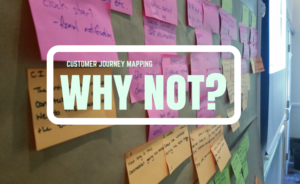Customer Journey Mapping? Why not?
Customer journey mapping. It’s probably the easiest starting point for anyone looking to improve the right customer experiences.

That said, I still encounter business leaders who see customer journey mapping as a waste of time. They don’t see it as a means to a very commercial end; to them it’s about employees pretending to be customers and having fun with post-it notes. At best, they won’t release any of their people from doing their day-job to go on a ‘jolly’. At worst, the journeys get mapped to tick a box, after which they simply gather dust.
So, this is the first in a short series of three posts on why journey mapping is important, how to make it effective and what to do with it.
First, let’s deal with the “Why?”. Customer experience professionals need the tenacity and resilience to win everyone over, whether it’s buy-in to the very concept of CX or asking for cross-functional representation in workshops. It’s not easy when those leaders want instant gratification for any activity.
Showcasing how journey mapping leads to better experiences, which in turn improve sales, revenue and retention is acutely important. But that alone sometimes isn’t enough to shake cynics out of the complacency tree. They’ll say the business is making money, they have satisfied customers and employees know what they’re doing; why change, why spend time doing what we call “journey mapping”?
One approach to get them to sit up and take notice is looking at the flipside; ask “Why not?”. What if we don’t do journey mapping, will we miss out on anything? What happens if we don’t try and understand what it’s really like today and should be like tomorrow to be a customer? Well, here are just a few things that will happen…
No meaningful purpose
The mission statement and vision, the guiding principles, should be about customers not the organisation. Absent a real understanding of customers’ needs, hopes and expectations a business can only operate in a vacuum. There’s no consensus around what should be done so everyone will carry on doing their own thing, preserving the corrosive effect of silos.
We waste money on the brand
Advertising expenditure in the UK this year is expected to be over £20bn. Yet such investments will be wasted if the promises made by the brand are not backed up by the reality of the experience. After all, the brand is what people tell each other it is, based on what they remember – not what the strapline says. And we all know what impact the presence of broken promises has on a relationship.

That’s the customer experience team. They do what they call customer ‘journeys’…
We measure the wrong thing
It’s easy to measure the most obvious things but is that simply a process audit of what the business thinks should happen? Journey mapping will highlight the things customers value the most; we need to know how well do we do what’s most important. It also avoids employees feeling pressured to chase a number rather than feel empowered to give the right experience.
We waste effort
Money, time and resource are all finite but one of the great things about journey mapping is that it is very helpful at prioritising what to do next. With a deep empathetic view of customers it becomes a lot easier to challenge personal agendas, inwardly-focused projects or new products that fit in the “technology for technology sake” basket. It’s easy to work out what things are really important to customers but we’re rubbish at doing, as well as preserving the things we’re good at.
Complacency eats away
The gap between customer expectations and reality is one of the key drivers of a sustainable business. A company may feel secure because there’s no obvious burning platform. As consumers, we have exposure to many companies across a variety of sectors and so our expectations of better experiences are rising as quickly as our tolerance of poor ones are falling.
We miss a big trick
An essential component of effective journey mapping is to see it from the employees’ perspectives, otherwise we have no idea how easy or difficult it is for our people to deliver the right experiences. They know about fragile processes, about broken hand-offs, about a lack of risk-free empowerment and inflexible policies. Their ability to deliver the experience is a link in the chain that can’t be kinked or broken.
We hand over an advantage to competitors
Chances are, your competitors are mapping their customer journeys too, meaning they will be in a better position to take customers away from you. They are de-risking the sustainability of their business by understanding what their – and your – customers will respond to positively
CJM does many things, not least it informs the customer strategy, it gets employees behind a common purpose and it focuses effort in the right place. More than that though, it gives a business confidence and context for what it does, organising the thinking that will start to change things for the better.
It’s an incredibly powerful tool but it must also be disciplined and structured. Therefore next in the series I’ll look at the ‘rules’ for how we can map journeys effectively and finally we’ll look at what to do next once the journey is mapped.
Thanks for reading the post, I’d love to hear what you think about journey mapping.
Jerry
Jerry Angrave is a Certified Customer Experience Professional (CCXP), a CX consultant with an extensive corporate background ‘doing the doing’ and specialises in professional development for those in customer experience roles. Feel free to contact him with any questions – by email to [email protected] or by phone on +44 (0)7917 718072. More details at the website www.empathyce.com.

Great “WHY” thank you very much Mr. Jerry